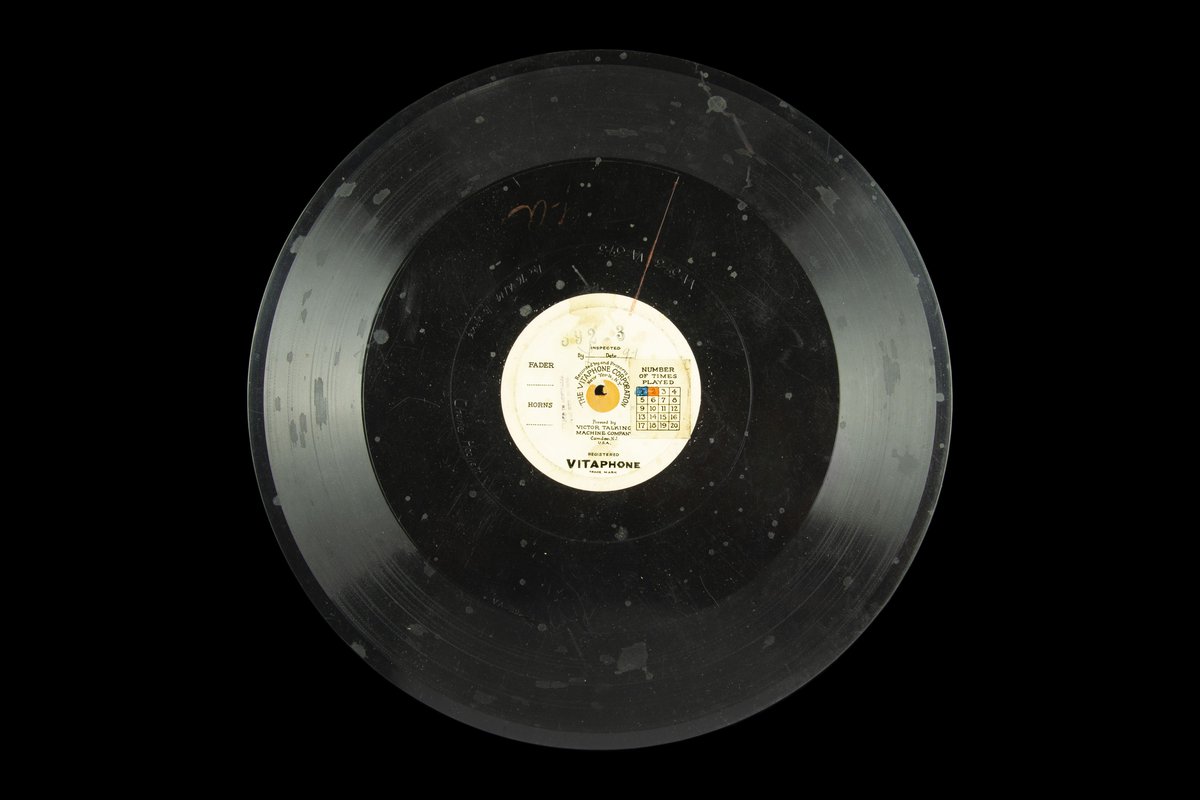When Western Electric developed the Vitaphone for Warner Brothers, it changed movies forever. Early filmmakers experimented with sound but couldn’t match it perfectly with motion pictures. The Vitaphone solved that, creating synchronised playback through a vinyl disc manually linked to a film projector. The system received wide-spread acclaim from its use in the first Vitaphone feature, Don Juan (1926), which featured a synced score from the New York Philharmonic and sound effects, and then a year later in The Jazz Singer, the first film to feature dialogue. Warner Brothers billed the Vitaphone as “the marvel of this marvellous age” and it certainly ushered in a new one: the success of Don Juan and The Jazz Singer signalled the end of silent cinema.
Curator Notes
Since the beginning of motion pictures, there had been many attempts to create the ‘talkies’. From William Dickson’s experiments in the mid-1890s with the Kinetophone to Alice Guy-Blaché work with Gaumont's Chronophone system from 1902, not to mention the Phonofilm and the Vivaphone, the Phonorama, the Synchroscope and the Biophon. But it wasn’t until Western Electric’s Vitaphone in 1926 that a sound system had truly been commercially successful or revolutionised the industry. In fact, earlier failed attempts had damaged the notion of talking pictures with poor synchronisation and low sound quality disappointing audiences. Instead theatres would hire musicians and often even have their own in-house orchestras to accompany silent film screenings.
Vitaphone used a sound-on-disc system which means the soundtrack was not printed on the film but was housed separately on phonograph records. The turntable that played the discs and the film projector ran off the same motor at the same speed. The projectionist only needed to line up the cuing mark on the disc with the cuing mark on the film for the sound to be correctly synchronised with the picture. Vitaphone also used electrical recoding and amplification methods, giving superior sound quality and the ability to throw sound all around huge cinema palaces.
An early adopter of new technology, Sam Warner of Warner Brothers convinced his eldest brother Harry along with financers Goldman-Sachs to purchase Western Electric’s sound system, forming the Vitaphone Company in 1925. On the 5th of August 1926, at the Warner Brothers Theatre in New York City, the studio released the first Vitaphone feature film, Don Juan which included an orchestral score and sound effects but no spoken dialogue. The night’s program also included eight short Vitaphone films starring the opera tenor Giovanni Martinelli, violinists Mischa Elman and Efrem Zimbalist, and Al Jolson. Johnson, who according to Hollywood legend instantly transitioned the industry to the talkies in The Jazz Singer (1927) with his famous line, “You ain’t heard nothing yet”, in fact spoke this same line in the short A Plantation Act (1926) which was shown as part of the festivities. The success of the evening lead to the release of The Jazz Singer a year later, which like Don Juan featured an orchestral soundtrack, sound effects but also included two minutes of spoken word, making it a part-talkie.
The success of the Vitaphone system paved the way for the transition to sound pictures, however the sound-on-disc process itself was short-lived, soon to be replaced with an improved sound-on-film system. Between 1929 and 1933, Western Electric, RCA, Fox-Movietone, and the Tri-Ergon, Tonfilm and Klangfilm had all developed versions of optical sound-on-film quickly making sound-on-disc obsolete.
– Curator Chelsey O'Brien
Works in this group
Another experimental sound film made in 1926 was "The Voice from the Screen," where Edward B. Craft, executive vice president at Bell Laboratories, explains the Vitaphone recording system and its labor, filming the popular vaudevillian duo Witt and Berg.
Related works
Content notification
Our collection comprises over 40,000 moving image works, acquired and catalogued between the 1940s and early 2000s. As a result, some items may reflect outdated, offensive and possibly harmful views and opinions. ACMI is working to identify and redress such usages.
Learn more about our collection and our collection policy here. If you come across harmful content on our website that you would like to report, let us know.
Collection
Not in ACMI's collection
On display until
16 February 2031
ACMI: Gallery 1
Collection metadata
ACMI Identifier
Curatorial section
The Story of the Moving Image → Moving Pictures → MI-05. Sound and Colour → MI-05-C02









